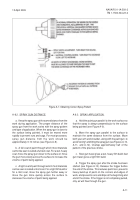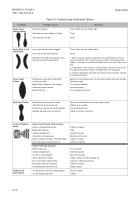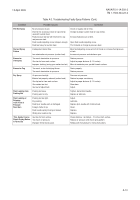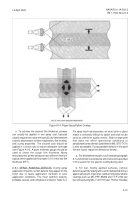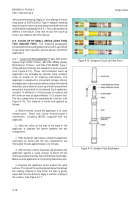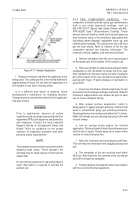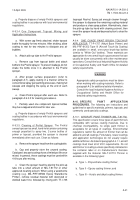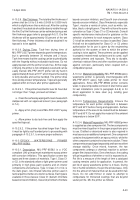TM-1-1500-344-23-2 - Page 187 of 240
A-17
NAVAIR 01-1A-509-2
TM 1-1500-344-23-2
15 April 2009
from epoxy coatings such as MIL-PRF-22750 and
MIL-PRF-23377 can be removed using MIL-T-81772
Type II Thinner. Residue from waterborne coatings
such as MIL-PRF-85582 can be removed using a
combination of water and TT-I-735 (Isopropyl Alcohol).
Consult the local Environmental Affairs Office for
guidance on pertinent regulatory requirements.
A-8.5. BRUSH AND ROLLER APPLICATION. Brush
or roller application of paint may be used when painting
small areas or when spray painting is not convenient or
permitted. The advantage of brush and roller application
is that the paint does not become atomized and airborne,
thus minimizing safety and health concerns.
A-8.5.1. Brush Application. Brush application shall be
limited to small nicks, chips, or scratches. When brushing,
the coating should be applied in one direction, then
cross brushed to completely cover the area. Near the
end of each stroke, the brush should be gradually lifted
to prevent excessive roughness from brush marks. The
coating material should be stirred frequently during use
to avoid settling. A brush applied coat should be allowed
to dry completely before applying subsequent coats.
A-8.5.2. Roller Application. In roller application, the
coating material should be placed in a paint tray having
a sloping bottom. The tray must be sized to accommodate
the roller and coating material. The roller is dipped into
the tray and rolled back and forth until it is coated.
Excess material on the roller is removed by rolling out
on the tray grid. The coating is applied by slowly rolling
it back and forth across the surface until uniform coverage
is obtained. Once a uniform coating is achieved, allow
it to dry completely before applying additional coats.
During roller application, adjacent strips should be
overlapped as in other methods of painting. Since the
roller will not fit into corners or other tight areas, these
surfaces may be coated using a brush before beginning
the roller application. The roller should follow the brushing
promptly to avoid lap marks. When applying paint by
roller, several coats may be necessary to achieve
adequate film thickness.
A-8.6.
ADHESION TESTING. Adhesion testing may
be used for quality control of newly applied coatings
when it is directed by aircraft/component specific manual
or local directives, or when poor adhesion or poor
surface preparation is suspected. Adhesion testing can
also be used to evaluate quality characteristics of old/
existing coatings. If the primer coat is the only coat
applied, then this test applies to the primer. If the primer
coat is to be topcoated, then this test applies to the
topcoat only. This test is applicable to primed/painted
areas greater than 2 square feet in total area.
A-8.6.1. Wet Tape Adhesion Test. Allow the primer/
paint to dry at least 48 hours before performing the tape
test. Use 4" X 4" square cut cheesecloth (CCC-C-440)
layers to equal a pad 1/8" thick. Saturate the pad in
water and place it against the surface to be tested.
Overlay a larger sheet of polyethylene (A-A-3174 Type I
Class 1) over the wet pad and tape the edges down,
using AMS-T-21595 Type I masking tape or equivalent.
Mark the polyethylene sheet with the date and time.
Allow 24 hours dwell time and then remove the cloth and
wipe the area dry with clean, dry cheesecloth. Before
one minute passes, apply a one inch wide by six inches
long piece of ASTM D6123 Type II flatback masking
tape (adhesive side down) across the test area. Ensure
that four inches of the tape covers the test area and
two inches are left unattached for gripping purposes.
Press the tape down in the test area with a firm hand
pressure (use of tape and decal applicator is also
authorized). Grip the two inch loose end of the tape and
remove the tape in one abrupt motion.
A-8.6.2. Pass/Fail Criteria. If no paint/primer was
removed, the adhesion test passed. If more than one
square inch (total) of paint/primer was removed, the test
failed and the entire surface must be stripped and
re-coated in accordance with this manual. If paint/
primer was removed but the total area removed was
less than one square inch, then a retest must be
performed in accordance with the following paragraph.
NOTE
It may be more economical to strip and recoat
rather than retest.
A-8.6.3. Retest of Failed Area Less Than One Square
Inch. Perform three additional wet tape tests in adjacent
areas to the failed area. All three tests must pass (no
coating removed). The coating is considered to have
failed adhesion requirements if any coating was removed
in the three retests. If this is the case, the surface must
be stripped and re-coated in accordance with this
manual. If no coating is removed in the retest, touch up
the removed coating from the first test and continue
processing.
A-8.6.4. Adhesion Testing for Touch-up Areas. In order
to test for proper adhesion of small areas of touch-up
coating (less than two square feet, total), a dry tape test
is authorized. Allow the coating (primer/paint) to dry for
Back to Top





